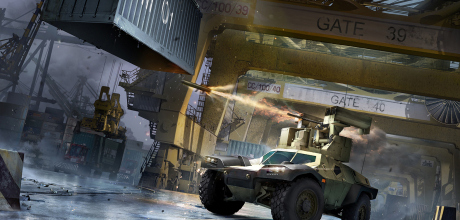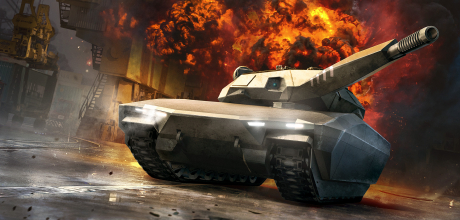
When it comes to new vehicles, Update 0.22 contains a number of progression ones, including the long-awaited top Tier Chinese Main Battle Tanks. It does, however, also contain some new premiums – for one, the PTZ-89 that we introduced earlier, but also a low-Tier Armored Fighting Vehicle called ZBD-86 (or Type 86 IFV). Now, you might be thinking something along the lines of “I’ve seen this before” – and yes, you would be right, because the story of the ZBD-86 begins, as it often does with earlier Chinese vehicles, in Russia – or perhaps even earlier, in the United States, depending how you look at it.

ZBD-86
In the 1960s and 1970s, the Chinese military was partially in disarray, still reeling from the blows dealt to it during the Cultural Revolution and the losses from the Korean War that alone did cost the Chinese more than a hundred thousand soldiers, although some estimates claim that the toll could have been several times higher.
The People’s Liberation Army was, contrary popular belief, neither blind nor incompetent and the commanders did care for the welfare of their soldiers, unwilling to throw away their lives needlessly. China paid close attention to military developments and doctrines deployed in the 1950s and in the 1960s by the Soviets and the Americans – especially the development of the armored personnel carriers.
The Russians were generally deploying wheeled APCs like the BTR-152 while the Americans were developing a series of tracked APCs that eventually resulted in the adoption of the most common western APC, the M113. The Chinese liked the American approach more due to its increased off-road capabilities. The Russians thought that their next anticipated battlefield – Europe – would have well-developed infrastructure, but China offered no such thing, making off-road capabilities essential. That is why the Chinese decided to adopt a simple, mass-produced APC that would be suitable for the classic “battle taxi” role the Americans were building their APCs for as well.
In short, these vehicles were only very lightly armored and were not intended to be fighting the enemy directly. They would deliver the infantry to battle (in reasonable safety from small arms) and, if encountering real resistance, would drop off the infantry squad and bail out or, at best, support the troops from some distance in order to not expose themselves too much. Anything larger than a bullet would cut straight through their armor, which is why they carried only very limited amount of firepower (usually only machineguns) in order not to attract undue attention.
The result of the Chinese development of such a vehicle was the Type 63 Armored Personnel Carrier. It was a simple, cheap and rugged machine – little more than a steel box on a tracked suspension. It did, however, what it was designed to do and a large amount of these vehicles were made over the years with over a thousand exported to Africa and Middle East where it is, in fact, in service until this day thanks to a large batch delivered to Iraq in the 1980s.
On the other hand, it did share a number of drawbacks with other vehicles of its class that would soon become apparent because by the time this vehicle came into service in China, the Vietnam War was just heating up.
During the war, a large number of the American M113s were used in the field, both by the South Vietnamese and the Americans themselves. The results were mixed. While the vehicles did offer some protection against bullets, they were extremely vulnerable to mines and IEDs (to the point of the soldiers feeling safer exposed on top of them than inside them) and could also be easily knocked out by RPGs. Contrary to their original doctrine, they were routinely getting into firefights with the enemy with their armament (usually consisting of a machinegun only) and armor proving woefully inadequate for such a role.
For the Americans, the solutions to the issue were the mostly improvised ACAV vehicles with more machineguns, gun shields and other improvements but to the Chinese, the flaws of the doctrine became quite apparent.

BMP-1 destroyer in Iraq
In the meanwhile, the Soviet Union accepted the BMP-1 in service in 1966. To say the Chinese were impressed would be an understatement. The machine was sleek and featured more protection (especially frontally) than the older “boxy” designs, but what made it truly formidable was its (perceived) firepower. At the time of its introduction, the Soviets were boasting that they had an IFV armed with a gun that was comparable to a MBT in firepower. And if that wasn’t enough, the vehicle was also equipped with the Malyutka guided missile launcher. Just how effective the system could be was shown during the 1973 Yom Kippur war where the Egyptian Malyutka teams and dug-in BMP-1s decimated the Israeli tank forces in Sinai. The American Patton tanks have proven to be especially vulnerable to ATGMs.
The reality, of course, was a bit different. The BMP-1 had its drawbacks – for one, the gun wasn’t really accurate or effective against enemy armor. It was more or less a reliable device to deliver HE shells but its performance against armored targets was erratic at best. The vehicle was also cramped and the protection was generally lousy, especially in urban areas. But, of course, the Chinese and the Americans didn’t know that back then and even in the hands of the Arab armies, it performed reasonably well.
And so the Chinese decided that they also wanted such a vehicle. Of course, there was a bit of a problem with that because this was the era of the Sino-Soviet split. Both countries, each under a different strain of communism, had their differences for almost two decades that escalated into the Sino-Soviet border conflict in 1969, in which the Chinese acquired their first T-62, analyzed it carefully and eventually upgraded their own tank fleet with many elements derived for it.
The Soviets were, naturally, not exactly thrilled to share their newest toy under such circumstances and even though the incident resulted in an uneasy peace and the relations between the two powers eventually returned to normal, any military cooperation was out of the question. And so the Chinese remained without an Infantry Fighting Vehicle and did not adopt the IFV doctrine until 1979 when the issue became truly urgent.
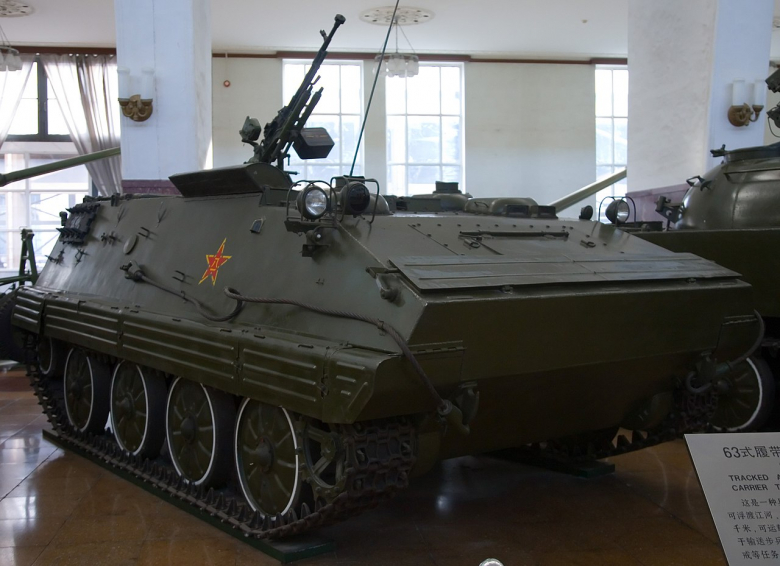
Type 63
The relationship between China and Vietnam has always been uneasy. By the end of the 1970s, both countries had been ruled by the communists but the victory over the Americans empowered the Vietnamese leaders and greatly improved their morale and self-confidence, much to the annoyance of the Chinese government that was more interested in vassals, not equals. In 1978, the Vietnamese intervened in Cambodia to oust the infamous Khmer Rouge movement out. The thing was, the Khmer Rouge was Chinese-backed and the Chinese didn’t quite like the thought of their protégés (as vile as they were) being kicked around. As a result, they decided to teach the Vietnamese a lesson and attacked Vietnam from the north.
Even though both countries claimed victory after three weeks of heavy fighting in mountain and jungle areas and tens of thousands of causalities, the truth was that it was mostly a Vietnamese victory that emboldened them further. Many lessons were drawn from the war, but the most relevant for this article was the one about Chinese APCs.
When the war launched, the Chinese infantry used the Type 63 APCs, trucks and, in some instances, the infantry just had to move on foot in heavy terrain. It was a disaster – the Vietnamese ambushes decimated them and the Type 63, much like the M113, had proven to be too vulnerable and unable to fulfill its tactical role. The mobility was also inadequate as many Type 63 APCs bogged down to the point where they could not be recovered.
This was a serious wake-up call for the Chinese military commanders and the issue of obtaining a new infantry fighting vehicle had become urgent. The development of the new IFV started soon afterwards, in 1980, under the designation of WZ-501.
To overcome the issue of limited experience with such vehicles, it was decided, once again, to rely on the old and proven strategy of copying existing designs. The BMP-1 – by that time a rather widespread vehicle – was taken as the basis. The Chinese acquired a BMP-1 from somewhere and simply copied it between roughly 1980 and 1985. In 1986, the vehicle was officially accepted in Chinese service under the designation of ZBD-86 with full-scale production running since 1992, more than two and a half decade after its introduction to Soviet service.
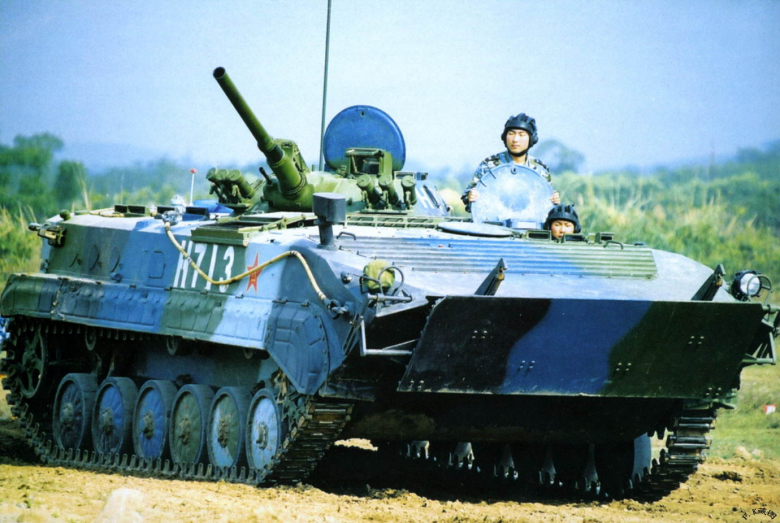
ZBD-86
Design-wise and component-wise, the vehicle was mostly identical to the Soviet BMP-1. It had a crew of three and could carry 8 infantrymen in the back.
The armor was made of steel with the following thicknesses (based on German military measurements):
- Upper front plate: 9-12mm (at 80 to 84 degrees)
- Lower front plate: 19mm (at 57 degrees)
- Sides: 16mm (at 14 degrees)
- Rear: 4mm (the doors were 17mm thick)
- Turret front: 23mm (at 45 degrees)
- Turret rear: 13mm (at 22 degrees)
- Turret roof: 6mm
- Bottom: 9mm
- Roof: 12mm
- Engine deck: 6mm
While acceptable in 1966, this is not much by today’s standards and there are some reports that the armor might in fact have been even thinner, although most sources claim it’s identical to the BMP-1.
The main armament was a copy of the 2A28 Grom 73mm smoothbore gun with the same issues as the original weapon. This gun was automatically loaded, its rate of fire was around 8 rounds per minute and could hit its targets at around 700m to 1300m accurately (theoretical range was over 4000m). Being a short (L/29) smoothbore, it fired HE and HEAT rounds that could penetrate around 300-350mm of armor (although their anti-tank performance was quite unreliable). The gun could depress to -3 degrees and elevate to +30 degrees. The vehicle carried 40 rounds of ammunition. The gunner also had laser rangefinder and day/night sights at his disposal.
The secondary weapon of the vehicle was a HJ-73 Red Arrow guided missile system. The Red Arrow wire-controlled missile in its basic form was a copy of the Russian Malyutka. It was used to destroy armored targets within 3000 meters from the vehicle. Its range was from 500 to 3000 meters, although the later, improved versions had the maximum range extended to 5000 meters. Its penetration capabilities were roughly comparable to the Malyutka system (some 400mm of steel). The vehicle carried 4 missiles in total. And last but not least, one in four ZBD-86 IFVs was equipped with a HN-5 MANPAD system to ward off enemy planes and helicopters.
The ZBD-86 was powered by a copy of the Soviet UTD-20 engine called 6V150. It’s a water-cooled diesel engine producing 293 horsepower – quite sufficient for its 13.3 tons. Its maximum speed is 65 km/h and, of course, it could swim like its Soviet counterpart.
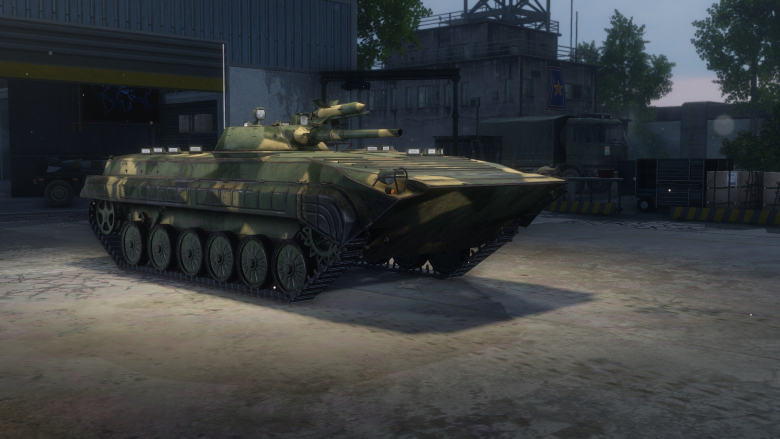
After the mass-production launch in 1992, it took several years for the vehicle to appear in public and by the time it did, it was considered to be completely obsolete. The production estimates range wildly from around 1000 to as many as 7000 vehicles built. China attempted to remedy its drawbacks by introducing a large scale of improvements to the design later on before finally moving to a different IFV, but that is a story for another time.
Visually, it’s quite difficult to recognize the ZBD-86 at first glance from the original BMP-1, which likely contributed to the confusion regarding its deployment and exports. It seems that the vehicle was exported to several countries including Iran, Iraq and Burma, but given its similarity to the BMP-1, these records are hard to confirm. There are rumors that the Iranian BMP-1s are in fact the Chinese Type 86 IFVs, but one thing is for sure – a number ZBD-86 IFVs remain in Chinese service to this day.
In Armored Warfare, the ZBD-86 will be a Tier 3 Premium AFV. We will disclose more about the means of obtaining it in the future.
We hope that you will like it and will see you on the battlefield!




